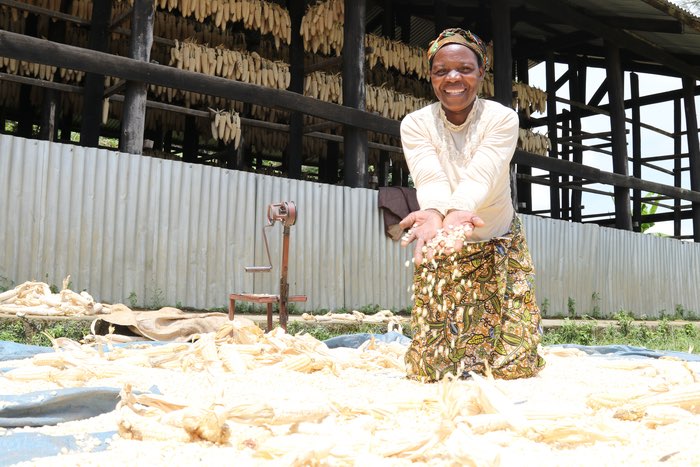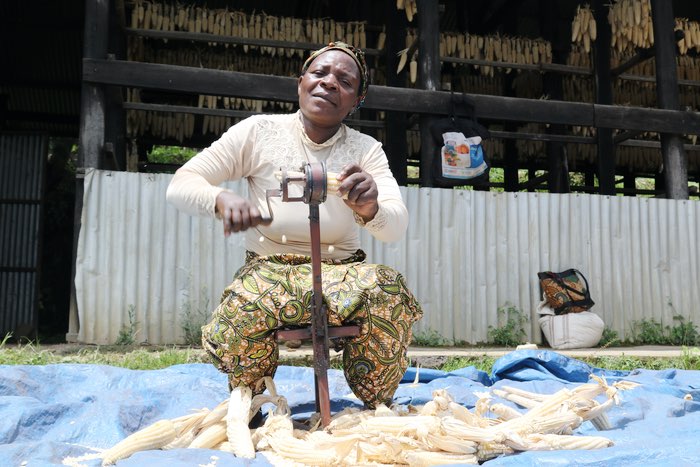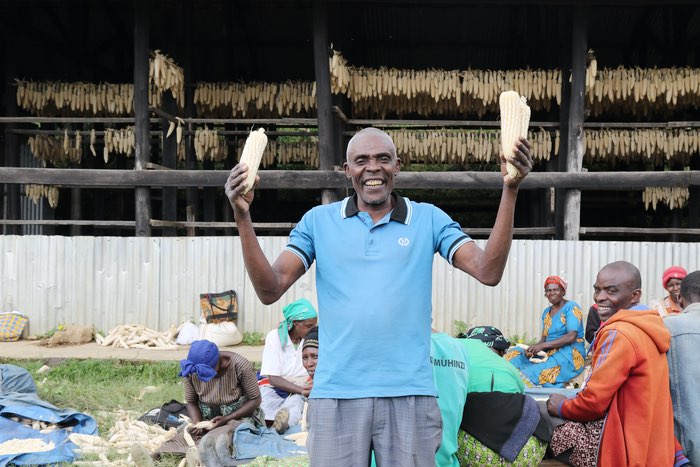
Petronila Mujawamariya with quality maize grains. Her production has increased from 2 to 6 metric tons due to WFP support through the FtMA initiative. Photo: WFP/JohnPaul Sesonga
Located within the gently sloping green hills of the Rugendabari sector in Burera district, northern Rwanda, lies Rugandu village. This area is fertile and mountainous, with its altitude ranging from 1,728 meters to 4,098 meters above sea level, and with temperatures between 18°C and 20°C.
Here I met Petronila Mujawamariya, a 52-year-old farmer and member of the “Cooperative d’animateurs de cultivateurs de Rugendabari” (COOPCRU), a cooperative dedicated to improving the livelihoods of maize and beans for smallholder farmers in this area. Its members strive to overcome challenges ranging from low yields due to limited good agriculture practices, limited access to effective post-harvest knowledge, and unstable food prices due to lack of access to markets.
In Rwanda COOPCRU is one of 425 smallholder farmer organizations supported by the UN World Food Programme (WFP) under the Farm to Market Alliance (FtMA). “The initiative aims to increase food productivity and income of smallholder farmers, develop commercial viability by providing adequate information, investment opportunities, and support smallholder farmers at all stages of the food value chain process – from seed to market”, said Anastasia Mbatia, WFP’s FtMA Deputy Director and acting Head of Smallholder Agriculture Market support unit.

Petronila Mujawamariya threshing maize grains beside a maize drying shed. She is a member of COOPCRU cooperative located in Rugengabari sector in Burera District-Northern Rwanda. Photo: WFP/JohnPaul Sesonga.
FtMA has transformed the lives of over 120,000 farmers in Rwanda, with women comprising 46 percent of the farmers supported by WFP. Thanks to the cooperation with implementing partners such as Rwanda Rural Rehabilitation Initiative (RWARRI) and CORDAID, smallholder farmers’ food production has increased, and post-harvest losses reduced, with surplus sold to buyers which has also increased their household income. This impactful work is made possible through the generous funding from the people and the government of New Zealand.
As I approached the cooperative, Petronila and other members of COOPCRU were busy threshing maize grains beside a maize drying shed. Petronila, seated on a small wooden chair and holding a hand-operated corn thresher, was visibly enthusiastic. With a white cloth wrapped around her head, she shared her story with a smile. “Before being trained by FtMA on good agricultural practices and post-harvest maize management, my maize harvest was very low at 2 metric tons per hectare. However, after applying the skills I learned, my harvest increased threefold to 6 metric tons per hectare,” she said excitedly.
According to national statistics, 72.1 percent of Rwandans live in rural areas and primarily engage in small-scale household agriculture. Female-headed agricultural households make up a significant portion of this demographic with 89.5 percent, compared to 74.5 percent of male-headed households. Additionally, 69.3 percent of agricultural households rely on farming as their main livelihood activity, with women leading 77.7 percent of these households compared to 67.9 percent led by men.

Musuhuke Patrice, the president of COOPCRU cooperative in Burera District, poses for a photo. WFP has linked farmers to markets and input service providers. Photo: WFP/JohnPaul Sesonga
Despite their efforts, smallholder farmers face substantial food losses, estimated between 20 to 40 percent, due to poor food handling during harvest. They also depend on extension services with inadequate capacity in post-harvest handling and marketing. To address these challenges FtMA, along with a consortium of value chain actors, facilitates the participation of rural smallholder farmers across the entire maize and beans value chains. This approach aims to increase their marketable surplus, enhance produce quality, and improve living conditions in rural communities.
COOPCRU demonstrates the positive impact of the FtMA initiative. “WFP trained all 36 COOPCRU members on good agricultural practices, and our maize harvest increased significantly. The cooperative’s total maize harvest rose by more than 50 percent, from 42 MT to over 70 MT, worth 15 million Rwandan franc per season,” said Musuhuke Patrice, the president of COOPCRU. He added: “Thanks to WFP, we have been linked to maize buyers and agricultural service providers. We can now plan beyond the farm gate with forward delivery contracts that ensure timely delivery of quality maize grains at a minimum floor price.”
The 425 WFP-supported cooperatives in Rwanda sell over 20,000 metric tons of maize annually, with 20 percent retained for home consumption. Since 2015, FtMA has successfully engaged farmers in Kenya, Rwanda, Tanzania and Zambia and has developed a network of service delivery centers through which farmers interact with service providers. WFP’s long-term experience, widespread presence and ability to share and scale best practices and success stories serves to boost local and international partnerships.
“Through FtMA, WFP has improved the agricultural productivity and profitability of over 120,000 smallholder farmers across 425 cooperatives in Rwanda. A recent yield estimation exercise revealed that WFP-supported maize farmers achieved an average yield of 2.9 MT per hectare, that is 76 percent more than the national average of 1.7 MTs per hectare,” said Andrea Bagnoli, WFP Representative and Country Director.
To address quality food production concerns, the alliance has facilitated access to post-harvest handling and storage tools and trained farmers in proper maize drying techniques. This has enabled farmers to meet market standards and secure better prices.
Since its inception in 2015, FtMA has facilitated the production of over 90,000 MT of marketable surplus of maize, beans, rice, and Irish potatoes, valued at over USD 28 million. The programme has also enhanced the governance and financial management capacities of cooperatives, ensuring their sustainability and effectiveness. These efforts align with Sustainable Development Goals (SDGs) 2 (Zero Hunger) and 17 (Partnerships for the Goals), showcasing a successful model for rural development and smallholder farmers empowerment.
